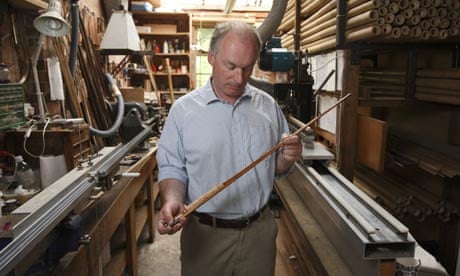You'll need a good eye and a very steady hand: the tip of a fine split-cane fly rod measures 1.5mm across, roughly half the diameter of a matchstick – and it's a hexagon of six equilateral, triangular strips of tapered bamboo glued together.
"We're working," says Edward Barder who, from a workshop on a Berkshire river bank, produces what many regard as the finest split-cane rods in the world, "to tolerances of a thousandth of an inch. With a natural material. A difference of five-thousandths in size will totally alter the action and character of the rod."
First, a little history. Fishing rods have been around for about as long as men. In the beginning, they were bits of stick. Later, they were turned and jointed and tapered, but always of indigenous wood – in Britain, maybe ash or blackthorn. They were effective, but heavy. They had a tendency to snap. Once bent, they stayed bent.
Then, in the 18th century, a new wood arrived from India. It was anything but heavy, it didn't break, and it always sprang back into shape. What's more, rodmakers discovered that if you split a bamboo pole, planed the strips down to a taper and spliced them back together, you could even improve on nature, making a rod with hitherto unimagined qualities of lightness, strength and resilience.
The process, pretty much refined by an American, Hiram Leonard in 1878, took off: in Britain, dozens of companies turned them out into the 1950s. But then along came cheap, factory-friendly fibreglass, followed by the carbon fibre used by most of Britain's estimated 3.5 million anglers today. And, just as quickly, the breathtakingly beautiful, but prohibitively labour-intensive, split-cane rod vanished.
With his colleague Colin Whitehouse, Barder – who's been hooked on them ever since, aged 17, he repaired his father's favourite fly rod – makes between 40 and 50 split-cane rods a year. Each takes around 60 hours, over four months. First, you temper your bamboo pole – only the very finest Tonkin cane from China, straight, unblemished and with the knots at least a foot apart – over a soft flame, driving out the moisture and stabilising the wood (bamboo is, Barder says, "like nature's fibreglass – strong, dense longitudinal fibres in a natural resin") but without scorching or weakening it. Then you carefully split it into between 12 and 24 strips, using a knife and mallet. After that, you file and sand both sides of each knot. Next, you reheat the wood in the flame, temporarily softening it so you can set it perfectly straight in a vice.
Then comes the milling machine, a bespoke piece of precision engineering. The heat-straightened strips are laid out side by side, six at a time, with the knots staggered (you don't want two knots side by side) and marked up to show where the handle, reel seat and joints will be.
The machine is set up with infinitesimal care to produce a compound taper according to measurements that Barder keeps secret, and the strips sent through the cutter once, then again to arrive at their final tapered shape.
Then you stick the strips together with a special glue, and wrap twine round them clockwise, then anti-clockwise, in a binding machine, and hang them up to dry straight and true.
Next, sand off the glue residue and the outer rind of the bamboo to reveal its "power fibres", and fit the suction-fit nickel silver ferrules (joints in a two- or three-piece rod) and champagne-grade cork shives for the handle. Turn the handle to shape, fit the olive-wood reel seat, attach the hardened steel line guides, and varnish the whole thing several times to an immaculate finish.
The result, says Edward in very English understatement, "looks nice". Actually, it's a work of art as much as a feat of engineering, frighteningly delicate yet immensely powerful. It will sell for between £1,400 and £1,800, and a fisherman seeking perfection will have to wait 18 months for one. Looked after, it will last generations.
Watch Edward Barder make a split-cane fishing rod in our online audio slideshow here from Monday
